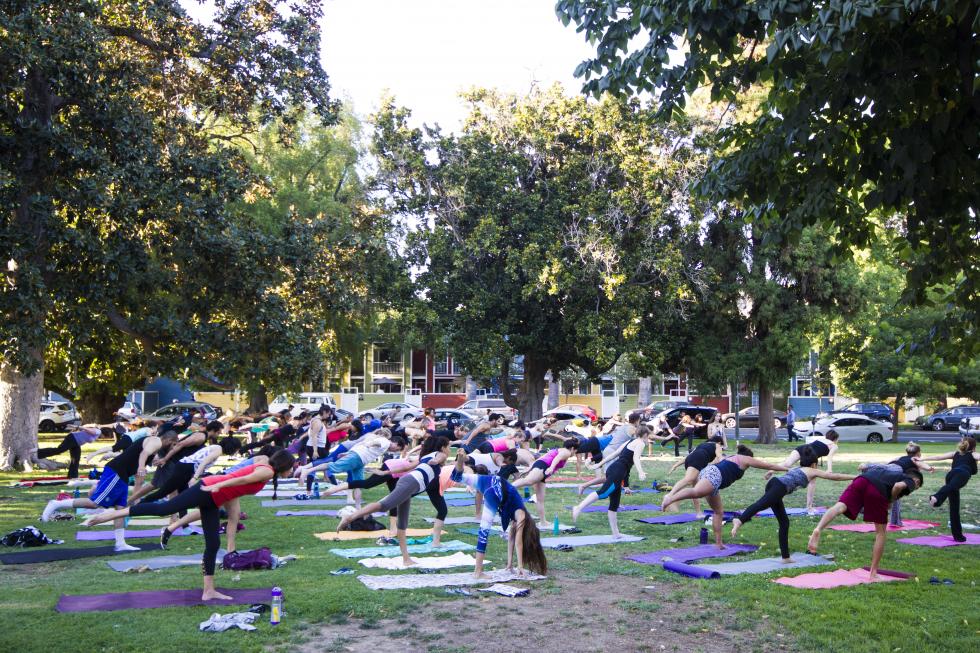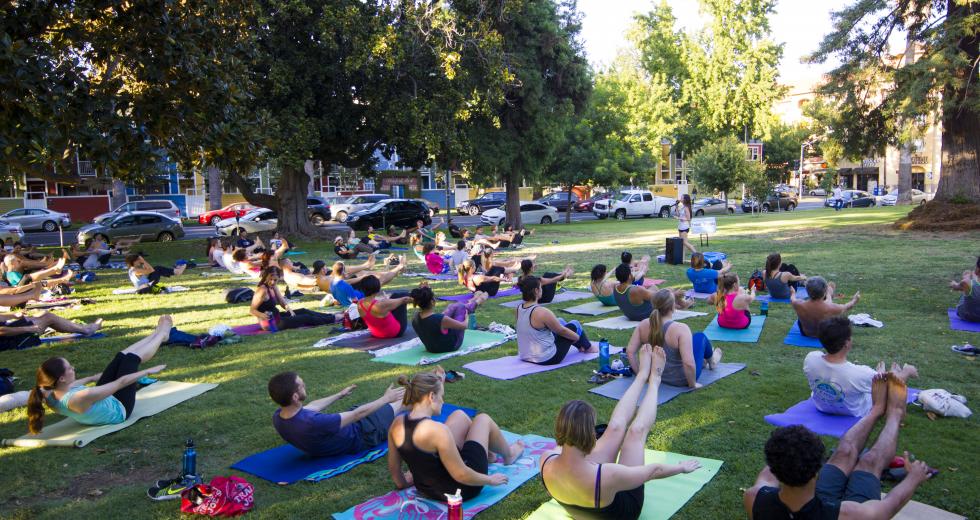It’s where you have a picnic. Play a pick-up soccer game. Do yoga in the fresh air. People-watch. Daydream. Take a breath. The park is a central part of the urban experience as a gathering spot, a green space and a respite from hectic city life.
As a local steward of the urban experience, the Midtown Association recently announced plans to form a nonprofit arm called Midtown Parks to activate five parks in Sacramento — Fremont Park, Winn Park, Truitt Bark Park, James Marshall Park and Sutter’s Fort State Historic Park — by making infrastructure improvements and planning calendars chock-full of activities. The nonprofit is expected to be up and running by fall in time for its first official fundraiser, the Midtown Mini Open, a miniature golf tournament.
“Midtown is a growing and developing area, so this is our chance to evaluate how inclusive our parks are of the people who live, work and visit here,” says Emily Baime Michaels, executive director of Midtown Association, a property and business improvement district. “We can offer so much more than grass and a block of trees.”
The purpose of the new Midtown Parks will be to bring more
activities and people to five local parks, such as yoga classes
at Fremont Park. (Photo courtesy Midtown Association)

Funding for Midtown Parks will come from a mix of grants and private donations, and Michaels anticipates the annual operating income to be anywhere between $100,000 and $1 million, depending on what capital improvement projects are underway.
This new public-private management arrangement is partly modeled on Bryant Park in New York City. Even though that space is part of the New York City Department of Parks and Recreation, it’s managed by the private nonprofit organization Bryant Park Corporation, which accepts no general public funds and operates the park on assessments on surrounding property, fees from concessionaires and revenues generated by public events.
Midtown Parks is also taking cues from Klyde Warren Park in Dallas and Occidental Square in Seattle to learn how to create dynamic public spaces that operate under public-private ownership. It will also team up with funding partners such as the Capitol Area Development Authority, which has previously funded many local park improvements.
“We can’t relieve the entire financial burden,” says Wendy Saunders, CADA’s executive director and chair of Midtown Association’s board of directors. “It’s still the responsibility of the City [of Sacramento] to do mow-and-blow maintenance, but by partnering with Midtown Parks to offer more programming, we can make the parks more successful by encouraging proper use and discouraging vagrancy.”
Sacramento Vice Mayor Steve Hansen says this new partnership is crucial and recognizes the leadership of the Midtown Association and CADA, “as they find new ways to make our city better. Midtown Parks will be a key partner as we work to rehabilitate and activate our beloved central city parks.”
Fremont Park at 15th and Q streets has already benefited in recent years from the Midtown Association and CADA’s support. Years ago, Saunders says the park was a drug hot spot, and residents didn’t often spend time there — or dare to walk through it, for that matter.
Movie night at Fremont Park in Sacramento. (Photo courtesy
Midtown Association)

After CADA purchased some of the surrounding housing to bring it under better management, the Midtown Association started sponsoring activities at Fremont Park last year, including free yoga classes, movies in the park and partnering with the renowned Chalk It Up! Festival. Gradually, the park saw increased traffic, which only intensified when business owners also got more involved in their neighborhood park.
“Fremont Park is our front yard,” says Andrea Lepore, co-founder of Hot Italian and founder and creative director of Lepore Development. “When the restaurant first opened [in 2009], it felt somewhat removed from the heart of Midtown, so we started offering free community events in the park like the Modern Italian Film Festival. Now, Fremont is a community gathering place and a real amenity for the neighborhood.”
Michaels says that once the new nonprofit arm is up and running, Midtown Parks will begin brainstorming tailored improvements based on each park’s location and demographics. New programming at James Marshall Park, for example, will include a lecture series; low-impact exercise classes; and opportunities for mentoring at the Hart Senior Center, located at the park. Winn Park at 28th and Q streets is the home of a long-vacant, 3,300-square-foot building that will soon be transformed into a restaurant by Clay Nutting, owner and operator of Canon East Sacramento. Michaels says it will then be the job of Midtown Parks to identify further improvements needed at Winn Park to encourage visits to the eatery.
“Just putting a restaurant in won’t do it alone,” Michaels says. “We’ll talk with neighbors about what we can do to make the park thrive, like a lighting redesign.”
Midtown Parks plans to add to Fremont Park’s roster of events, with a goal of offering activities every day of the week. Developer Bay Miry — creator of projects 1430 Q and 16 Powerhouse, both kitty-corner to Fremont Park — is looking at creating a pop-up component to provide more flexible event space.
“From a developer’s point of view, engaged and welcoming local parks help make new development possibilities more attractive and ultimately more successful,” Miry says. “Highly activated, well-maintained parks foster increased and repeated use, serve as gathering points for the community and encourage the public to linger longer in welcoming spaces.”
Midtown Parks also plans to install shade structures at the Truitt Bark Park at 19th and Q streets to make it more user-friendly during the peak heat of summer. And while Sutter’s Fort will continue to be managed primarily by the nonprofit Friends of Sutter’s Fort, Midtown Parks has plans to install better lighting around the gravel track to encourage after-work exercise.
“We see this as part of a larger strategy to make Midtown more livable,” Michaels says. “Parks can make the central city denser and encourage less traffic. People crave that urban environment — there’s no reason we can’t experience that in Sacramento.”



